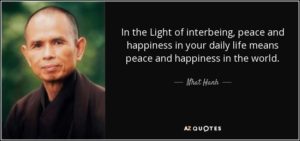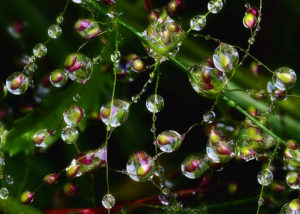If I were to sum up my work in the world in one word, it would be connection. This realization came after many years of teaching and writing about love and yoga, when it dawned on me that love and yoga are just two sides of the same coin of connection.
The term ‘yoga’ is a sanskrit word that can mean a few different things. The most common translation comes from yukta, meaning unity. Yoga also shares a common etymology with the word “yoke,” as in to join or bind together. This dual meaning demonstrates yoga can be both the realization of unity and the coming together of previously disparate parts, like bringing together body and mind, or heart, soul and spirit. In other words, yoga is both the process of connecting and the result of seeing everything as connection.
Love is about connection too; from two people connecting in the form of an intimate relationship to the ways we love ourselves by connecting to our soul’s purpose and our heart’s deepest longing. We love our family and communities, and some even love their country or God, which reflects the individual connection to something greater than oneself.
As I have walked this path of connection in the form of yoga and love, I have discovered there are three progressive stages of connection on this path of realization and many people simply do not go far enough.
By understanding what it means to truly be connected and experience unity with all things, we can further the evolution of consciousness, and in fact, the world.
I’d like to walk you through these stages and see how well-known poets, naturalists and mystics have expressed the beauty of these realizations.
1. Stage one: Seeing things as interconnected
The first stage of connection is largely an intellectual exercise in recognizing everything in this universe is connected and nothing exists on its own. Everything is meeting, joining, flying away from, or interacting in a million and one different ways as it has throughout history, and this will throughout the rest of time.
The world is a web of relationships, and this idea is often taught to young children when they learn about the circle of life or the water cycle. John Muir expressed it this way in his famous quote,
“When we try to pick out anything by itself, we find it hitched to everything else in the Universe.”
The flower cannot exist without the bee that pollinates it, nor the water that rains upon it or the soil from which its nutrients come. Seeing the world as connected is important to the survival of the species and the survival of the planet. When one ecosystem collapses, so do many others, and when one species becomes extinct, it can easily create a domino effect on others.
Humanity can be extraordinarily naïve when it comes to our blatant destruction of the environment, as if we are somehow separate from it. We are just as dependent on clean air and water as any other organism, and so we too depend on many organisms for our own sustenance. The survival of humanity depends on the survival of the world.
Mary Oliver summed it up marvelously in her famous Poem of the One World,
This morning
the beautiful white heron
was floating along above the water
and then into the sky of this
this one world
we all belong to
where everything
sooner or later
is a part of everything else
which thought made me feel
for a little while
quite beautiful myself.
Given enough time in this interconnected world, everything sooner or later becomes a part of everything else. Every molecule of air you breathe has been breathed a million times before. The matter that makes you up comes from the plants and animals you have eaten, all of which will return to the earth in your death.
Human beings exist in a web of relationships too, and one action affects the whole as well. This is summed up in the famous quote by Dr. Martin Luther King,
“Injustice anywhere is a threat to justice everywhere. We are caught in an inescapable network of mutuality, tied in a single garment of destiny. Whatever affects one directly, affects all indirectly.
We are social creatures: my well-being depends on your wellbeing, and vice versa.
But seeing things as interconnected is only the first stage of connection, because it still largely views the world as made of distinct objects acting upon each other, a kind of Newtonian physics of A interacts with B. Interconnection is rooted in the Western concept of causation, where one action affects another.
In reality, A depends on B just as much as B depends on A, which brings us to the next stage of connection: the realization of interdependence.
2. Stage Two: Seeing things as Interdependent

As we go deeper into the connected truth of reality, we find the truth of interdependence: everything is entirely dependent on everything else. Interconnection says nothing exists on its own, but interdependence says that since nothing can exist on its own, nothing truly exists at all.
The concept of interdependence is a key doctrine in almost all schools of Buddhism and comes by many names: dependent origination, dependent arising, interdependent co-arising and conditioned arising. The main idea is everything exists arises due to external conditions and has no inherent permanent lasting essence. Rather, it is dependent on everything around it and thus is interdependent.
Interdependence is an important realization for humanity to make, as we so often place the blame of societal failures on individual people, as if people do bad things in a vacuum. When in truth, the village that raised the child is responsible for the behavior of the child.
This idea is also captured in the famous Ubuntu phrase, “I am because we are.” No human being exists alone. We are all interconnected, and each of us derives meaning from the people that surround us.
The Vietnamese Monk Thich Nhat Hahn called this concept “interbeing,” and summed this perspective up marvelously in his teaching of being able to see a cloud in a piece of paper:
“If you are a poet, you will see clearly that there is a cloud floating in this sheet of paper. Without a cloud, there will be no rain; without rain, the trees cannot grow; and without trees, we cannot make paper.”
The philosopher Martin Buber summed it up in his short quip, “all of life is meeting,” meaning that A does not interact with B, but that C is the life we experience that emerges from the meeting of A and B.
Furthermore, we must include not just A and B, but the millions of interactions that must occur for anything to truly happen. Your existence right now is not just dependent on food, air, and water, but also gravity and the atmosphere of the earth and the millions of years of life that have evolved for you to exist. While the mind might want to divide the world up into objects acting upon one another, existence is trillions of times deeper and more complex than the mind can ever understand.
Simply recognizing that everything is impermanent and arises due to external conditions fails to account for just how deeply one thing reflects all other things.
So, in the next progression of understanding we can turn to one of the most beautiful metaphors to illuminate the nature of reality: Indra’s Net.
3. Stage Three: Seeing Indra’s Net

The concept is simple, but profound: Indra’s net is an infinitely large net of cords, and at each intersection of the net there is a multifaceted jewel in which there reflects all the other jewels in the net.
This metaphor describes the next stage of connection, the recognition that every microcosm carries within it the reflection of the microcosm. That within even the tiniest particle of matter there lies the entire universe.
Rumi summed this up perfectly with his popular line, “You are not a drop in the ocean. You are the entire ocean in a drop.” Everyone reflects the universe. Similarly, we are reflections of each other.
Another lovely metaphor used to describe this comes from Alan Watts, who often described the universe as a tree. Eventually, the tree bears the fruit of an apple, so you can conclude it is an apple tree. The singular reflects the whole. We live in a universe that creates people, and thus can say that this is a people’s universe, or to put it in another way, a conscious universe. This idea is closely connected to the idea that “God made man in his image.” Man reflects the creator.
Again, for an understand of this reality, we can turn to the path of awakening as described by Rumi,
There is a worm addicted to eating grape leaves. Suddenly, he wakes up, call it grace, whatever, something wakes him, and he is no longer a worm. He is the entire vineyard, and the orchard too, the fruit, the trunks, a growing wisdom and joy that does not need to devour.
Indra’s net is discovering we are the earth, the stars, the cosmos, and the worm too.
There is a reason why Rumi starts out his poem by talking about a particular worm in a particular vineyard. Any poet knows if they truly want to make their poem universal, they must make it as individual as possible. There is a big difference between saying “I had a rough day, but it got better” and, “I spilled coffee on my new white shirt on the way to the interview, only to find out it was scheduled for tomorrow.” Only by expressing something so deeply personal can we all relate to it universally.
Our spiritual path, then, is one of discovering that divine ocean inside of us and realizing we are that perfect jewel in Indra’s net. If we look deeply enough within, we can discover the whole universe. Mark Nepo put it wonderfully when he wrote,
“All living things, by virtue of being alive, have an innate vitality or life force that is empowered by the whole of life, and that becoming fully human is the process by which we discover and inhabit our innate qualities of spirit and our relatedness to everything.”
This is to say that no one exists isolated in not just space nor time either. A billion years of evolution is wrapped up in our DNA. We are connected to the millions of ancestors that toiled on the Earth. John O’Donohue put it this way:
Fashioned from clay, we carry the memory of the earth. Ancient, forgotten things stir within our hearts, memories from the time before the mind was born. Within us are depths that keep watch. These are depths that no words can trawl or light unriddle.
The idea of Indra’s net can help us to understand spiritual teachings like, “what you seek is within you,” or even “the kingdom of God is within you”, because we reflect all that is.
Of course, for all these teachings, do not take my word for it. They are meant to be discovered experientially, through the act of disciplined practice. Without walking the path this all becomes just an intellectual exercise. Meditate, practice yoga, open to love, and look within: what do you find?









